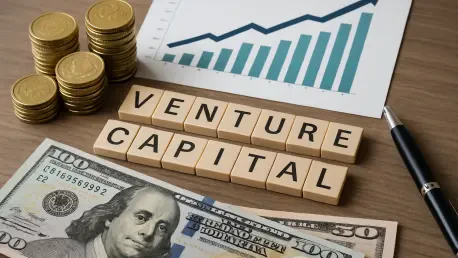Venture capital investment in health tech has surged to unprecedented levels this year, with billions poured into startups reshaping healthcare delivery, and a staggering $3.9 billion was raised in just the third quarter of 2025, reflecting a robust recovery that has caught the attention of investors and industry watchers alike. This roundup delves into diverse perspectives from industry reports, analysts, and market observers to assess whether this momentum signals a lasting revival or a fleeting spike. By compiling insights on funding trends, the role of AI, exit strategies, and future outlooks, this piece aims to provide a comprehensive view of the current health tech investment landscape.
Diving into the Funding Resurgence
Recent data reveals a remarkable uptick in health tech funding, surpassing the total investment seen in the prior year. With $4 billion and $4.4 billion raised in the first and second quarters of 2025, respectively, followed by the third quarter’s haul, the sector appears to be on a steep upward trajectory. Industry analysts note that this growth reflects renewed confidence, driven by innovations addressing critical inefficiencies in healthcare systems globally.
However, not all views are uniformly optimistic. Some market observers caution that the slight dip in quarterly figures could hint at underlying volatility. They argue that economic uncertainties, such as fluctuating interest rates, might temper this pace if broader financial conditions tighten. This divergence in opinion sets the stage for a deeper look into whether the current boom can sustain itself over time.
A key point of agreement among sources is the record-high average deal size, now standing at $7.7 million, alongside a 12% increase in deal volume. This trend suggests that investors are placing bigger bets on fewer, high-potential startups. Reports highlight significant rounds, such as a $243 million Series C for a leading health tech firm, as evidence of a maturing market where scale and impact drive capital allocation.
AI as the Core Driver of Investor Interest
Across various analyses, artificial intelligence emerges as the dominant force fueling health tech investments. Startups leveraging AI for practical applications, such as ambient note-taking and revenue cycle management, have drawn substantial funding, with one notable company securing a $210 million Series B. Industry voices emphasize AI’s ability to streamline clinical documentation and billing, making it a magnet for capital.
Yet, opinions differ on the risks of this AI-centric focus. Some analysts warn that an overemphasis on trendy technologies might overshadow other critical areas of healthcare innovation. They point out that while AI has raised over $1.2 billion for revenue cycle solutions since 2025, sectors like patient-facing tools remain underfunded due to longer paths to market readiness.
Another perspective stresses the transformative potential of AI despite these concerns. Supporters argue that its impact on workflow efficiency is undeniable, with tangible benefits already visible in reduced administrative burdens for providers. The debate continues on whether this narrow focus might limit broader, long-term advancements or if it represents a pragmatic starting point for deeper innovation.
Practical Solutions Trump Speculative Tech
A consensus among industry reports is the preference for actionable AI tools over speculative, futuristic solutions. Investments are heavily tilted toward technologies that offer immediate value, such as administrative aids, rather than complex systems for predicting major health events like heart failure. This trend reflects a cautious approach prioritizing quick returns over high-risk propositions.
Regional differences also shape this narrative, with U.S.-based investments focusing predominantly on practical tools due to market demand and regulatory clarity. In contrast, global adoption of more experimental tech lags, as some sources note barriers like cost and stricter oversight in other regions. This disparity raises questions about equitable access to cutting-edge solutions worldwide.
Critics of this trend suggest that an overly narrow focus on short-term gains could hinder groundbreaking progress in healthcare. They advocate for a balanced approach, urging investors to allocate resources to early-stage, patient-centric innovations even if commercialization timelines are longer. This tension between immediate impact and visionary goals remains a key point of discussion.
Exit Dynamics: Acquisitions Rise, IPOs Lag
The exit landscape in health tech presents a mixed picture, with acquisitions dominating over initial public offerings in 2025. Reports indicate that 42 VC-backed firms exited via acquisitions in the third quarter, mostly early-stage startups, signaling strong interest from larger players in consolidating promising technologies. This trend is viewed positively by many as a pathway for smaller companies to scale under established umbrellas.
Conversely, the IPO market has stalled after a brief uptick earlier in the year with a few notable public listings. Analysts attribute this freeze to policy risks, including potential legislation that could disrupt healthcare access and deter public offerings until at least 2026. Opinions vary on whether this environment stifles growth or simply redirects focus toward strategic buyouts.
A third viewpoint explores the implications of an acquisition-heavy market. While it benefits smaller players by offering quicker liquidity, some industry watchers express concern over market consolidation reducing diversity in innovation. They argue that fewer independent players could limit the variety of solutions reaching healthcare providers, sparking a debate on the long-term effects of this trend.
Strategic Insights from the Health Tech Surge
Synthesizing various perspectives, the standout insight is the sector’s robust funding recovery, underscored by the $3.9 billion raised in the third quarter alone. This financial momentum, paired with AI’s central role, points to a sector capitalizing on technological promise. However, the contrast between thriving acquisitions and dormant IPOs highlights external challenges that stakeholders must navigate carefully.
For investors and startups, multiple sources recommend focusing on scalable AI solutions that address immediate pain points in healthcare workflows. Timing exits to avoid policy-related headwinds is another frequently cited strategy, with suggestions to monitor legislative developments closely. Such actionable advice aims to help players maximize returns in a fluctuating environment.
Partnerships also emerge as a recurring tip for smaller firms seeking acquisition interest. Collaborating with established entities can enhance visibility and credibility, according to industry analyses. Additionally, staying agile in response to economic shifts is seen as crucial for sustaining growth amid uncertainties that could impact future funding rounds.
Reflecting on the Health Tech Investment Wave
Looking back, the discussions around health tech VC investment in 2025 revealed a sector brimming with potential yet tempered by caution. The surge in funding and AI-driven innovation painted a picture of resilience, while the stagnation in IPOs and policy concerns reminded stakeholders of persistent hurdles. Diverse opinions from industry analyses underscored both the opportunities and the risks that defined this period.
Moving forward, stakeholders should consider prioritizing strategic alliances to bolster market position, especially for emerging players eyeing acquisitions. Keeping a close watch on regulatory changes will be vital to anticipate windows for public listings beyond the current year. Additionally, exploring underfunded areas of health tech could uncover untapped potential, ensuring that the sector’s growth remains inclusive and forward-thinking for years to come.









